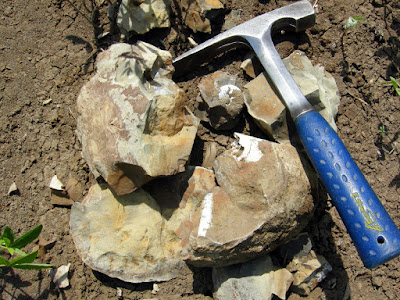Hammer helps geologist find the story behind the rock
 |
| A geologist’s hammer used to break up rocks, as well as a scale in the photograph |
Some wag from the 19th century once described geologists as “those crazy blokes with their wee little hammers, busy turning mountains back into molehills.”
That may be a small exaggeration, but we do like our hammers ? and we do use them freely on many an outcrop.
The reasons for this wanton ?vandalism? are twofold. First, few outcrops offer good, clean exposures of the rocks they hold.
Usually, some combination of graffiti, lichen, moss, weathering or water stains have intermingled to cover or confuse the surface. In which case, breaking off a piece is the quickest and easiest way to see what is really there (at the risk of flying rock shards).
The other reason, however, is more fundamental. For many rocks and minerals, how they break is nearly as diagnostic as any other observation we can make.
Take, for instance, the difference between shale and slate. Shales are just layered mudstones; other than bedding they have no internal structure. Thus, they tend to break irregularly and often are somewhat crumbly.
In contrasts, slates ? which are equally fine-grained ? have re-crystallized so that their clay minerals are all aligned. As clays are thin, flat minerals, that means slates split easily into thin, brittle sheets, often ready-made for shingles.
For other sedimentary rocks, breaking them allows an inspection of their sands and sediments, and sometimes of the cements holding them together. Also, many fossils (especially shells and fish) can be found where a rock breaks.
But the real fun starts when we break igneous rocks like granite.
Here, the minerals are all intermeshed and grown together. So if you break the rock, you have to break the minerals inside. This is guaranteed to reveal the true colors of those minerals, but it also shows something of how those minerals are put together as well.
Specifically, if you look closely at any broken piece of granite, you will see some dull, glassy minerals and also a number of flat, sparkly minerals. The knee-jerk assumption is that those flat reflectors are crystal faces that happened to be aligned with the break. But, look more closely and you?ll see at least some of those reflectors aren?t flat. They step up or down while still reflecting light at the same angle.
In reality, most of those facets are cleavage planes, places where the minerals broke along a systematic zone of weakness inside the crystal.
As such weaknesses mark variations in the chemical bonding of different atoms, they are repeated in some minerals at small intervals, and with specific orientations. Thus, micas (which have a single cleavage) peel off into thin sheets, and feldspars (which have multiple, intersecting cleavages) break either into tiny, block-like shapes or along stepped facets. On the other hand, minerals without cleavage, like quartz and garnet, do not break flatly and usually show more chipped or irregular surfaces.
So, as spring brings a sparkle to the rocks around us, take a closer look. Some of those glints may be more than just rain or snowmelt.
This is the opinion of Robert Wichman, a geologist and professor who has explored many of Minnesota’s state parks. He can be reached at newsroom@stcloudtimes.com.